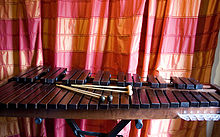
Back Ngelenge ANN خشبية (موسيقى) Arabic اكسليفون ARZ Xilófonu AST Ksilofon Azerbaijani سیلوفون AZB Ксілафон Byelorussian Ксыляфон BE-X-OLD Ксилофон Bulgarian ཤིང་དཀྲོལ། Tibetan
 | |
| Percussion instrument | |
|---|---|
| Classification |
Percussion idiophone metallophone lithophone |
| Hornbostel–Sachs classification | 111.212 (Set of percussion sticks) |
| Developed | 9th century |
| Playing range | |
 | |
| Related instruments | |
| balafon, txalaparta, laggutu, marimba | |

The xylophone (from Ancient Greek ξύλον (xúlon) 'wood' and φωνή (phōnḗ) 'sound, voice';[1][2] lit. 'sound of wood') is a musical instrument in the percussion family that consists of wooden bars struck by mallets. Each bar is an idiophone tuned to a pitch of a musical scale, whether pentatonic or heptatonic in the case of many African and Asian instruments, diatonic in many western children's instruments, or chromatic for orchestral use.
The term xylophone may be used generally, to include all such instruments such as the marimba, balafon and even the semantron. However, in the orchestra, the term xylophone refers specifically to a chromatic instrument of somewhat higher pitch range and drier timbre than the marimba, and these two instruments should not be confused. A person who plays the xylophone is known as a xylophonist or simply a xylophone player.[3]
The term is also popularly used to refer to similar instruments of the lithophone and metallophone types. For example, the Pixiphone and many similar toys described by the makers as xylophones have bars of metal rather than of wood, and so are in organology regarded as glockenspiels rather than as xylophones.
- ^ Henry George Liddell; Robert Scott, eds. (1940). "ξύλον". A Greek-English Lexicon. Henry Stuart Jones, Roderick McKenzie. Oxford: Clarendon Press. Retrieved 24 February 2023 – via www.perseus.tufts.edu.
- ^ Henry George Liddell; Robert Scott, eds. (1940). "φων-ή". A Greek-English Lexicon. Henry Stuart Jones, Roderick McKenzie. Oxford: Clarendon Press. Retrieved 24 February 2023 – via www.perseus.tufts.edu.
- ^ "Xylophonist | Definition of Xylophonist by Oxford Dictionary on Lexico.com also meaning of Xylophonist". Lexico Dictionaries | English. Archived from the original on 7 December 2020. Retrieved 19 September 2020.
